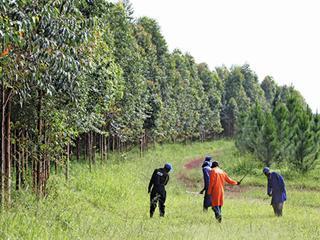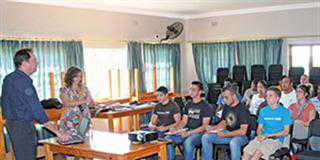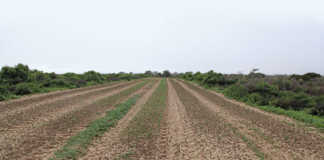
Global demand for wood products continues to grow, but established plantations in traditional commercial forestry countries cannot keep up because agricultural land is becoming increasingly scarce. One of the few remaining regions where new forestry plantations can be established is Africa north of South Africa. Although setting up greenfield projects on the continent can prove profitable in the long run, tenacity and patience are required due to the lack of development and frequent political unstability.
The New Forests Company (NFC) is one entity prepared to take up the challenge. This UK-based forestry company began operating in Uganda in 2004 and swiftly expanded to Mozambique, Tanzania and Rwanda. In the process, according to CEO Julian Ozanne, it has created 2 500 jobs and invested more than US$85 million (R850 million) in the development of plantations. This includes US$3 million (R30 million) spent on development projects for communities surrounding NFC’s plantations and timber value-adding sites.
“As a start-up company we’ve found it helpful to piggyback on South Africa’s expertise,” says Kenyan-born Ozanne. “South Africa has a 1,3 million hectare commercial forestry industry, and is the largest and most organised in Africa, with a wealth of knowledge, experience and skills.” Obtaining reliable statistics elsewhere in Africa is often difficult, but NFC estimates that Africa’s total commercial plantations, excluding South Africa, amount to 926 000ha.
Ethiopia has the continent’s second-largest commercial forestry industry, with a mere 120 000ha under plantations. As most of the continent’s commercial plantations are government-owned, there is plenty of opportunity to establish privately owned ones.
A cinderella industry
The existing plantations face major challenges, according to Ozanne. There are no associations to promote their interests, revenues are small, and research and development is virtually zero as most of the government-funded forestry research departments have been closed down. In addition, public sector officials have little understanding of the commercial forestry industry.
“For example, in Uganda, the company was initially considered an NGO planting a few seedlings around the country. Instead, we’d started 11 000ha of plantations from scratch,” says Ozanne. The company has also struggled with the government in Mozambique, which last year began taxing all fair value gains. By then, NFC had accumulated substantial fair value gains in that country, but had not yet earned a cent in revenue.
This was because the company had continually reinvested in its assets in Mozambique. NFC now faces a hefty tax bill on its asset value and has found it difficult to engage the government on the matter. NFC has also found that various cash-strapped African governments have allowed their existing pine, eucalyptus and cypress plantations to run down. In spite of this, they often still refuse to sell the plantations legally to private owners. Instead, large sections are harvested or sold off illegally. NFC believes that, corruption aside, these neglected commercial plantations are a waste of a potentially valuable resource.
NFC’s success
Of the five main greenfield commercial forestry developers in eastern and southern Africa – that collectively own 116 000ha of plantations – NFC is estimated to be the largest with 27 000ha. Ozanne believes that his company and its next two largest competitors will double their existing hectares under plantations within the next four to five years. NFC is already set to plant a further 1 000ha by the end of the current fiscal year.
“Our planting rates vary enormously from country to country,” he points out. “Of the 21 000ha of land we have in Mozambique, only about 8 000ha is plantable to forestry. “According to Forestry Certification Council standards, this is a very low conversion rate. But our rates in Uganda and Tanzania are closer to 70%, which means that across our operations we’re involved in a lot of mosaic forestry and conservation of indigenous forests.” Mozaic landscapes, as its name implies, seek to combine natural forests and biodiversity, productive agricultural land and forest plantations in a sustainable way.
Major deforestation
Ozanne explains that one of Africa’s greatest challenges is rampant deforestation of indigenous forests. While it’s estimated that indigenous forests cover about 675 million hectares, or 23% of the continent’s total land area, the United Nations’ Food and Agriculture Organisation reported that an area the size of Belgium – more than three million hectares – was deforested in Africa last year alone. And the growing population means that the rate of deforestation is increasing.
“The main reason is the need for energy,” says Ozanne.
“Only about 15% of East Africa’s population have access to electricity. The rest collect firewood, or make or buy charcoal for cooking. Up to 98% of the wood from Africa’s felled natural forest goes towards charcoal production. “The implications are frightening – it’s imperative that we try to save what we can of the remaining natural forests.” Without a massive change in the production of sustainable timber in Africa, he stresses, the continent faces a bleak future.
For this reason, he argues that sustainable commercial forestry in Africa needs to be implemented rapidly, and disagrees with the many conservationists who oppose it. He says that in the past decade alone he has witnessed first-hand the massive negative impact that rapid population growth has had on Africa’s natural environment. Despite the need to establish a sustainable alternative to this exploitation, NFC is currently unable to produce charcoal competitively from its own commercial forestry resources.
Informal charcoal producers can obtain their raw material at no cost, albeit mostly illegally, from natural forests. Also, much of the informally produced charcoal comes from very old hardwood trees and is preferred by consumers over charcoal made from NFC’s eucalyptus plantation thinnings. These consumers claim that the food cooked with indigenous wood charcoal tastes better. The situation is not helped by the fact that charcoal is cheaper than electricity.
Doing business in africa
“As a private greenfield commercial forestry developer in Africa, we struggled to raise investment capital,” explains Ozanne.
He adds that some of the early potential investors were sceptical about their concept because projections showed that while the business would ultimately be profitable, the first 17 years would reflect a negative cash flow.
Ozanne and his team are continually looking for more revenue streams to get the company to profitability. One such stream has come from government efforts to electrify parts of rural Africa; this has created a huge demand for wooden poles, which has created “a valuable source of early revenue”, according to Ozanne.
Another challenge which NFC faces in many African countries is acquiring land for commercial forestry development. Where there is land available, it is often difficult and confusing to get the necessary government approval. The company has also found that the skills levels of the people it recruits are virtually non-existent. Very few of its general labourers had ever held jobs before, having been mainly subsistence farmers.
“We’ve found that it takes five years to establish good working discipline and basic forestry skills among these employees,” explains Ozanne. Endemic government corruption is yet another challenge which NFC faces, as is strong opposition from powerful environmental rights groups.
Vigorous growth
Despite these challenges, Ozanne believes that NFC will benefit from East Africa’s projected economic growth. This is expected to be 7% to 8% during the next two years or so and the figure could climb to a massive 12% to 15% from about 2016, thanks to the region’s anticipated gas and oil boom. “Strong economic growth normally results in strong performance for the construction and infrastructure development sectors,” explains Ozanne, adding that this will create opportunities for the value-added wood industry.
With a growing middle class, Africa is an “exciting place to do business, even if it’s by the seat of your pants. It requires an entrepreneurial attitude and appetite for risk”. He adds that Africa’s energy sector also presents an opportunity for plantation products. Many industries still burn expensive oil products. As oil reserves decline and prices increase, African industries will start using renewable energy resources, including wood biomass.
Reaping rich rewards
According to Ozanne, returns on investments for greenfield commercial forestry development in Africa are high, ranging from 20% to 25%, while labour costs are still relatively low. “We operate in countries where unemployment rates are staggering,” explains. “The average formal employment rate is only 10% to 15%, with 85% of people working outside formal employment. To boost formal employment, some countries won’t implement minimum wages anytime soon.
Nevertheless, while low-priced labour helps in early-stage forestry investment, NFC is certified by the Forest Stewardship Council and applies 21st century labour practice standards.” Because NFC operates in countries north of South Africa, it benefits from US dollar-based revenues. About 42% of Africa’s demand for timber products is met by imports, and local producers gain from import parity pricing and dollar revenues. This has been an advantage for his company.
“An added benefit is that we can generally produce and sell our wood at lower prices than imported products,” says Ozanne. This means African businesses often prefer to buy from NFC. What’s more, as its plantations are in areas of timber scarcity, the company can generally dictate prices.
Where are SA investors?
Ozanne expresses surprise that since the establishment of his business in 2004, there have been no new entrants to Africa’s greenfield commercial forestry development sector. “Barriers to entry for this sector are continually increasing, so now’s the time to invest in plantations on the continent,” he says.
“Investors from South Africa, including the government, are ideally placed to take advantage of this opportunity. There’s already a lot of knowledge, research, experience and skills in the South African commercial forestry sector that can be utilised to successfully develop plantations elsewhere in Africa.”
Email New Forests Company at [email protected], or visit www.newforests.net.












